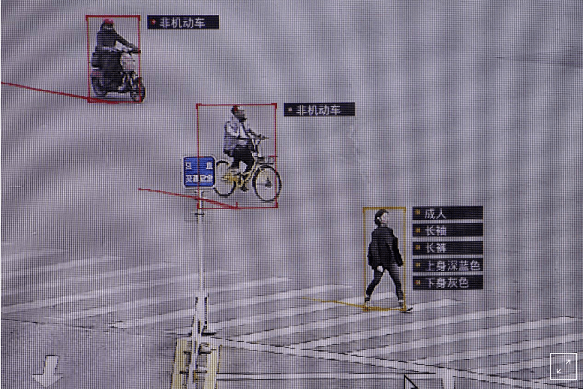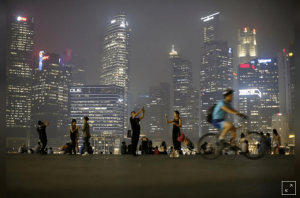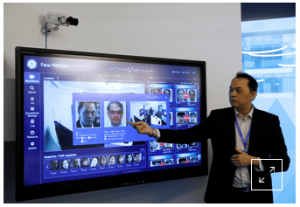The latest item to qualify in the “the Dystopian Future Is Now” category is a system that aims to help bartenders keep track of their customers with facial recognition and AI.
There’s just one teensy problem: Bartenders are really, really not into it.
The British company DataSparQ announced the launch of the “A.I. Bar” Thursday. It works by using cameras and sensors to place people who come up to the bar in a queue; it’s like a digital “take a number” system, but based on facial recognition.
People can see where they are by viewing themselves on a screen (with a number above their head, depicting their place in line). Bartenders will know who to serve by consulting a tablet that has pictures of all the people, in order of who they should serve first. It’s supposed to also help bartenders keep track of whose ID needs to be checked.
Recently, DataSparQ tested the system at a bar in London. Here’s a video showing how it works.
DataSparQ positions the facial recognition queue system as a win-win. It says customers will have less wait time, and that bars are poised to make more money with faster service. Customers, supposedly, hate waiting for drinks in line. But bartenders think the AI makes a problematic, technological mountain out of a decidedly human molehill.
“I just don’t see what this sort of technology would remotely do to mitigate all of the supposed service delay-based qualms that people have,” Asif Rizvi, a Brooklyn bartender at The Breakers, said. “At best it’s unnecessary. At worst, it’s yet another harbinger of the impending AI apocalypse.”
Mashable spoke with four bartenders in New York, San Francisco, and Las Vegas about their impressions of the queue system. Here’s what they think about the prospect of gettin’ a little help from an AI friend.
“We know what’s going on”
As a 5-foot-1 woman, there have been times at busy bars when I’ve wondered, “does my bartender even know I’m here?” The short answer is, yes — which is why most of the bartenders I spoke with didn’t see the basic need for this sort of system at all.
“Really good bartenders are really good at their own facial recognition algorithm, which is called common sense,” Rob Ready, the co-owner of the SF bar Piano Fight, said.
Essentially, the problem that this is purporting to solve is that people have trouble getting served in a fair order, in a timely fashion.
“The unspoken presupposition for at least the way they frame it is that bartenders have no idea what they’re doing, and don’t know how to handle this stuff,” Rizvi said. “We know what’s going on. We see it all.”
If the value proposition of the product is to be believed, bartenders, supposedly, have a hard time keeping track of who arrived when, and who needs a drink. According to the bartenders, this is one of the challenges of being a bartender, but not an insurmountable one. In fact, being able to manage this is part of what makes a bartender good at their job.
“The best bartenders are very present, and know what’s going on in their surroundings,” Olivia Hu, the co-owner of Oldtimers in Bushwick, said.
The Breakers, where Rizvi works, is one of those multiple-people-deep, all-the-way-around-the-bar, hot Brooklyn weekend spots. He says that service is challenging, but all bartenders have their patterns and workflow that make them, ya know, qualified for their jobs.
“We’re not computers, obviously, and I guess that’s kind of the point here,” Rizvi said. “But we have a habitual checking of things in certain orders that ultimately will average to everyone getting dealt with evenly.”
In short: Calm down, the bartender will get to you.
“Maybe it could work in a non-tipping culture”
The person this system seems made for is, again, someone who feels like they have problems getting served. But there’s a simple solution to this problem, that doesn’t take money out of the pockets of your hard-working barkeep: tipping.
“It’s the people that don’t take care of the bartenders that tend to get forgotten at the bar,” Daniel Keaveney, a veteran Las Vegas casino bartender who is currently works at the downtown Las Vegas restaurant Esther’s Kitchen, said.
Keaveney stressed that discretion about who gets served is a huge part of a bartender’s job, especially in a place like Las Vegas. Automating the service line simply would not work in a place with a “tipping culture” where high rollers and good tippers expect service, pronto — and where bartenders rely on those tips, too.
Keaveney and the other bartenders acknowledged that tipping culture in Europe, where this product comes from, is very different.
“Maybe it could work in a non-tipping culture,” Keaveney said.
But in a place like Vegas, or even Bushwick, this system would change the way bartenders target tipping customers, especially loyal ones. It is possible, though, that supposedly equitable service orchestrated by AI could provide more tips from happy customers, but the bartenders I spoke to didn’t express that.
Plus, discretion in serving isn’t all about tips.
“It’s a very human interaction”
There’s a sacred relationship between a bartender and a customer, one that is not always necessarily financial. An AI just wouldn’t get that.
“I understand the nuances of serving alcohol,” Hu added. “It’s a very human interaction.”
Bartenders cultivate regulars by actually having conversations. Or bartenders can mete out drinks like justice, awarding the well-behaved, while teaching the assholes a lesson. It’s also up to bartenders to look out for the safety of their patrons. Ultimately, the bartenders believe that an AI system would get in the way of all of that.
“A big part of bars is social interaction,” Ready said. “If you come up to a bar, and you’re a dick to the bartender, then, yeah, it might take them a little bit longer to come serve you the next time around. And that’s good because it teaches people to not be dicks to service industry professionals.”
Bartenders also use a lot of personal judgment when deciding whether or not to hand an intoxicated person another drink. Maybe, eventually, an AI might be able to read that. But right now, a queue system might make cutting someone off way too complicated if they’re insisting on being served because their number is up.
“That is one of the major responsibilities of a bartender, to know when someone might be harming themselves with alcohol,” Hu said. “It’s difficult for a computer to make that call.”
“You’re trying to apply data and tech in a context that is very human,” Ready said. “That’s what doesn’t seem to fit.”
“I’d be creeped out”
DataSparQ said that it interviewed 2,000 people to learn that one of the reasons people leave bars is because they don’t like waiting in lines. But Ready thinks a wait in line is nothing compared to a machine capturing your biometric data and broadcasting it for everyone at the bar to see.
“I wonder if there was a question that said, if you saw yourself in a livestream video behind the bar, and the thing was scanning your face, and recognizing your emotions, where would that fall in the list of reasons to leave that bar?” Ready asked, um, hypothetically. “I’d be creeped out.”
Cities, countries, public, and private spaces are all grappling with whether and how to introduce facial recognition. These bartenders thought a watering hole was not a good place to start.
“There’s a privacy thing within a bar. You’re supposed to feel safe in a bar,” Keaveney said. “Maybe I don’t want to be seen in that bar like that, maybe I’m trying to hide out a little bit.”
To the bartenders, making a service system automated and transparent to customers doesn’t seem worth giving over your precious, biometric data.
“This doesn’t sound like anything more than a glorified take-a-number kind of system, and I don’t see why it has to collect your data in order to do that,” Rizvi said.
“You’re fixing something that’s not really broken”
Mostly, bartenders were flummoxed by how the system would actually help them.
“There’s never a situation where the bar is busy because there’s a ton of people there, and the solution is, ‘someone help these bartenders with facial recognition technology,'” Rizvi said.
First, they questioned how adding the extra step of consulting a tablet would actually make them able to serve more people, as the company claimed in its press release. Wouldn’t having to check a tablet, and match a face to a line item in a tablet, end up taking more time?
“They’re trying to solve a problem by creating a bigger problem,” Ready said.
Next, one of the problems the tech says it aims to solve is people pushing, shoving, and cutting in line. But the bartenders — keen observers of human nature — said that surely customers would find a way to game the system (say, by palling up with whoever’s first in line).
Finally, if someone really is bothered by waiting in line for a drink, they can always just … go to another bar.
“If you’re in a busy bar, there’s going to be a lot of people,” Rizvi said. “If you don’t like that, go to a different bar. There will always will be one.”
Mostly, the bartenders just didn’t see the need for the product in the first place. Yes, bars get busy. But it’s a bartender’s job to manage that, and a customer’s job to trust that person — and treat that person well — in order to keep the bar the functioning, very human place that it is.
“It just feels to me like it’s a fancy use of tech to solve problems that don’t exist,” Ready said.
Or, in Rizvi’s words, “you’re fixing something that’s not really broken.”
Feature Image Credit: Datasparq




